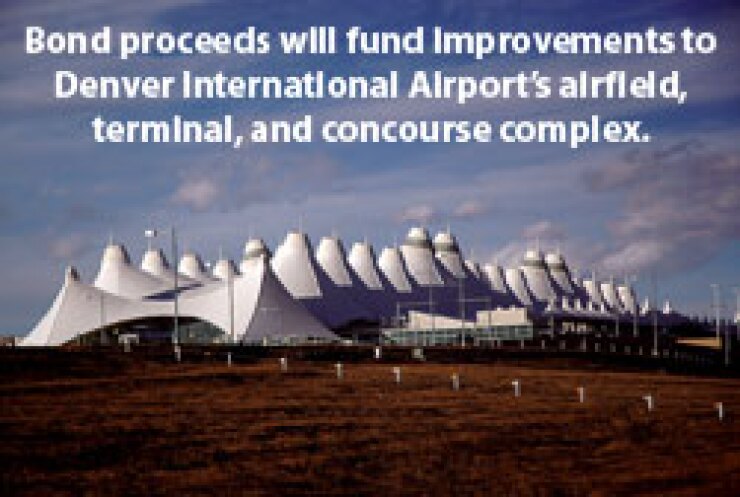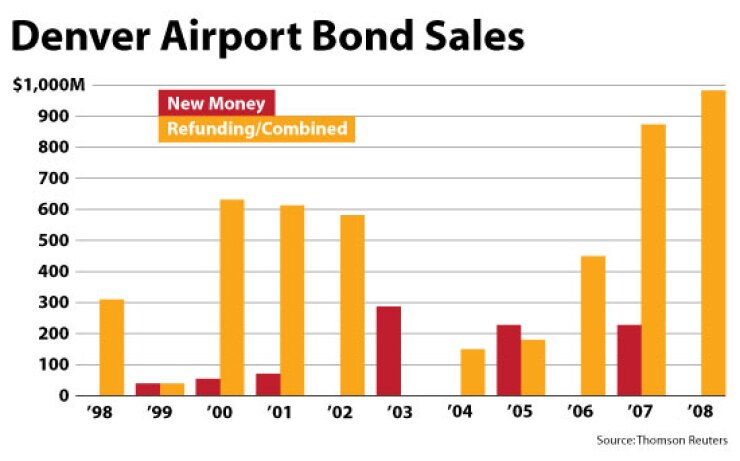

DALLAS — Facing strong headwinds from the ongoing recession and a weak airline industry, Denver plans to issue $235 million of fixed-rate airport bonds next week and $100 million of variable-rate bonds in November.
This month’s issue will include $71 million of Build America Bonds as Series B, with the $161 million Series A offered as tax-exempt. The issue scheduled for the week of Nov. 9 will be variable rate, backed by a letter of credit from JPMorgan Chase Bank.
JPMorgan is lead underwriter on next week’s negotiated deal, with Barclays Capital, Piper Jaffray, and Loop Capital as co-managers. Jefferies & Co and Estrada Hinojosa serve as co-financial advisers. Hogan and Hartson and Bookhardt O’Toole are co-bond counsel with Peck Shaffer & Williams as disclosure counsel.
Denver expects to take advantage of the low interest rate environment and the limited supply of good credits.
“The market seems to be firming for high-quality issuers,” said Margaret Danuser, debt administrator for the city and county of Denver. “Investors are fairly familiar with our stable credit and like [Denver International Airport’s] prospects. We anticipate working hard with our underwriters to achieve the lowest yields possible for the transaction.”
While Denver carries a triple-A credit for its general obligation bonds, the airport bonds are rated A-plus by Standard & Poor’s and Fitch Ratings and A1 by Moody’s Investors Service.
Despite turbulence in the airline industry, the rating agencies maintained stable outlooks in affirming their ratings.
“The stable outlook is based on our expectation that United Airlines will continue to operate a major hub at DIA, that cash-flow debt-service coverage will remain good, and that the airport will maintain a good liquidity position,” wrote Standard & Poor’s analysts Robert Hannay and Kurt Forsgren. “The airport’s ability to prudently implement its capital plan during the current challenging airline industry environment remains an important rating factor.”
Despite the financial struggles of its carriers, Denver International is experiencing strong growth in traffic. The figures from August, the most recent, showed that nearly 4.9 million passengers used the airport, an increase of 2.3%. It was the second-busiest August on record at DIA and came after an all-time record July of 5.1 million passengers.
“While it is still likely that we will finish the year down slightly from our record year of 2008, passenger traffic is better than we had predicted, and we believe that’s a direct result of the strong competition in the Denver market,” aviation manager Kim Day said in a release on the figures.
The airport is in the midst of a $583 million capital improvement plan that runs through 2012. Proceeds from the upcoming issues will be used for improvements to the airfield, terminal, and concourse complex, as well as roads, parking, baggage system and transportation facilities.
United Airlines remains DIA’s largest carrier, though its share of enplaned passengers fell below 47% this year, down from 59% in 2004.
“While UAL’s dominance continues to diminish, the airline still represents the largest contributor to airline-based operating revenues, thus its scheduling decisions could significantly influence the overall financial operations of the airport,” Fitch analysts noted. “To date, UAL’s service reductions at the airport (approximately 7% as compared to 2008 levels) have not been as severe as UAL’s overall system cutback in operations.”
Frontier Airlines, which emerged from bankruptcy this month under the new ownership of Republic Airways Holdings, was the only Denver-based carrier operating at DIA until its sale. The discount carrier based its entire business plan on the opening of DIA in 1995, creating a hub-and-spoke system, and later adding a feeder carrier called Lynx Aviation.
Frontier and United now face strong competition from Southwest Airlines, which began serving the airport in 2006 and has steadily expanded operations there. Southwest now provides almost 14% of total enplanements based on first half 2009 traffic figures.
In hopes of keeping 900 Frontier jobs in Denver, the City Council last week reviewed a package of incentives offered to Republic for maintaining or increasing employment in the city. Details of the proposal have not been released, but officials said they include a variety of tax breaks. Frontier now has about 4,000 employees in the city.
But the success of United could be more germane to the airport’s credit, according to analysts.
As a traditional hub airport, United handles the lion’s share of connecting traffic, which made up more than 44% of DIA’s total traffic in 2008, according to Standard & Poor’s. Connecting traffic is seen as more vulnerable to economic adjustments than so-called origin and destination traffic. Southwest, unlike United and Frontier, is a point-to-point carrier.
Fitch notes that DIA’s updated capital improvement plan through 2012 will be largely debt financed and could pressure the airport’s operating costs. A consultant’s forecast, based on low traffic growth and issuance of nearly $400 million of additional debt, indicates cost per passenger rising to more than $15 by 2015.
“Any unanticipated declines in traffic given the current market conditions could either exacerbate the increases in CPE [cost per enplanement] or lead to tighter financial flexibility,” analysts wrote. “Fitch believes that management has adequate resources to cushion airline charges and maintain sound coverage levels in the event a downturn in traffic occurs.”





